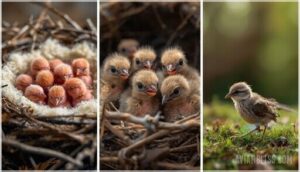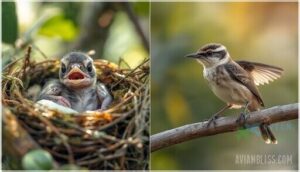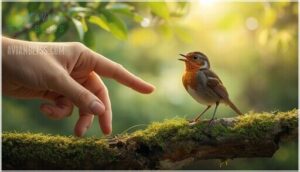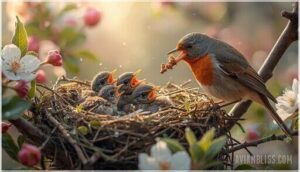This site is supported by our readers. We may earn a commission, at no cost to you, if you purchase through links.
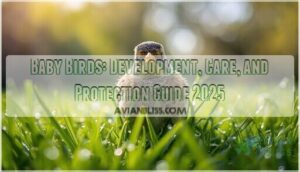
Understanding the difference between a nestling that needs rescue and a fledgling learning to fly can mean the difference between life and death for these tiny creatures. Baby birds move through distinct stages of development, each with different needs and risks. Knowing what to look for helps you make the right choice when you encounter one.
Table Of Contents
- Key Takeaways
- Baby Bird Development Stages
- Identifying Baby Birds
- Caring for Baby Birds in The Wild
- Parental Care and Feeding
- Threats and Conservation of Baby Birds
- Frequently Asked Questions (FAQs)
- What if I find a baby bird?
- What is the bird that gets rid of the baby?
- What should I do if I see a baby bird?
- What does a baby bird look like?
- What to do if you find a baby bird?
- What are baby birds called crossword clues?
- Can you keep a baby bird as a pet?
- What do I feed a baby bird that fell out of its nest?
- How do you identify a baby bird?
- What to feed a baby bird that fell out of the nest?
- Conclusion
Key Takeaways
- Most baby birds you find on the ground aren’t abandoned—fledglings with feathers are learning to fly and should be left alone since their parents are watching nearby.
- You can safely return featherless nestlings to their nests without causing abandonment, but fledglings with nearly complete plumage need space to develop flight skills on their own.
- Cats pose the greatest danger to baby birds with over 90% of cat encounters leading to fatal bacterial infections even without visible wounds, making immediate wildlife rehabilitation contact essential.
- Habitat loss and fragmentation increase nest failure rates by up to 197 times compared to continuous forests, making native vegetation planting and pet control critical for baby bird survival.
Baby Bird Development Stages
Baby birds grow fast and change in ways that might surprise you. From blind hatchlings to bold fledglings, each stage brings new abilities and challenges.
Let’s look at the key phases of baby bird development and what makes each one unique.
Hatchlings, Nestlings, and Fledglings
Baby bird stages unfold in three distinct phases. Hatchlings emerge naked and helpless—think tiny pink aliens with closed eyes. Nestlings develop fuzzy feathers and open eyes but stay put in the nest. Fledglings hop around with nearly full plumage, testing their wings.
Altricial vs. precocial species show different timelines: songbirds need weeks of parental reliance while ducks walk within hours.
Survival rates vary wildly by anatomical indicators and environmental factors throughout development. The term refers to young animal development in early stages.
Physical Changes and Milestones
From hatchling to fledgling, you’ll witness rapid transformation. Ventral feather tracts emerge by days 4–5 as downy feathers sprout. By day 5, primary flight feathers poke through, enabling your nestling to grasp and stand. Eyes fully open around days 7–8, sharpening sensory awareness.
Most birds are fully feathered by days 12–13, though some head down remains. Size changes happen fast—some chicks nearly double overnight during peak growth. As hatchlings convert, they enter the nestling stage, relying on parental care.
By weeks 4–5, ability development reaches fledgling readiness with strong wings and perching confidence. Plumage maturation continues after independence through molting stages of bird development.
Altricial Vs. Precocial Chicks
Not all chicks hatch equal. Altricial babies—like songbirds and parrots—emerge helpless, eyes shut, naked or barely downy. They’re nest-bound for weeks, requiring intense parental investment in feeding and protection.
Precocial chicks—ducks, chickens, geese—hatch with eyes open, downy feathers, and surprising mobility. They walk or swim within hours, guided rather than fed by parents.
These developmental differences shape nesting strategies and survival rates. Altricial species hide nests carefully to protect vulnerable young, while precocial chicks scatter early, reducing total brood loss. Each strategy offers evolutionary advantages depending on habitat and predation pressure.
Identifying Baby Birds
Knowing whether you’ve found a nestling or a fledgling makes all the difference in how you should respond. The physical traits of baby birds change quickly as they grow, and spotting these differences helps you determine if a bird needs your help or is simply learning to fly.
Let’s look at the key features that tell you what stage a young bird is in.
Distinguishing Nestlings From Fledglings
When you spot a baby bird, feather development tells the story. Nestlings stay put in the nest with mostly bare skin or soft down covering their bodies. Fledglings have left home and sport nearly complete feather coverage with visible wing and tail feathers.
Mobility differences matter too—nestlings can’t grip or perch, while fledgling birds hop confidently and grab branches.
Both stages show parental dependence, but intervention ethics demand you leave fledglings alone unless they’re injured. Identifying bird stages through behavioral cues helps you know when to step in.
Common Physical Traits by Age
During the first week after hatching, you’ll notice dramatic shifts in hatchling features. Pin feathers emerge around day 4, eyes open between days 5 and 8, and body temperature climbs from 21°C to nearly 27°C. These bird development stages show clear altricial traits:
- Days 0–4: Bare pinkish skin, closed eyes, no thermoregulation
- Days 5–9: Pin feathers unsheathing, grasping ability, stronger calls
- Days 10–14: Fledgling plumage mostly complete, flight feathers 6–10mm long
Nestling development accelerates rapidly, with tenfold mass increases before fledging. Downy feathers give way to functional flight capability right on schedule.
Juvenile Vs. Adult Plumage
Once a fledgling leaves the nest, you’ll see its juvenile plumage—duller and more mottled than the vibrant adult feathers it will eventually wear. These downy feathers protect young birds from predators and signal low dominance to territorial adults.
Small passerines like sparrows shed this cryptic coat within their first year through molting patterns, while eagles take up to five years to gain their iconic white heads.
The functional significance of subdued plumage coloration becomes clear when you watch avian young development unfold across species variation and feather structure differences.
Caring for Baby Birds in The Wild
Finding a baby bird on the ground can feel like a moment of panic, but knowing what to do makes all the difference. The right response depends on the bird’s age and condition.
Here’s how to help these vulnerable chicks when they need it most.
When and How to Return Birds to The Nest
You might wonder if that tiny nestling on the ground needs your help. If you find a featherless or partially feathered nestling bird, you can absolutely return it to the nest. Contrary to myth, handling won’t cause abandonment. Warm the chick in your hands first if it feels cool, then gently place it back.
Can’t reach the original nest? Build a surrogate nest using a small container lined with dry grass and secure it nearby. Watch from 25 feet away for an hour. If parents don’t return, contact wildlife rehabilitation professionals.
Species variations matter—cavity nesters rarely return after fledging, but proper reintegration outcomes show 80% parental acceptance when done right. Remember legal considerations under the Migratory Bird Treaty Act before caring for young birds yourself.
Handling Injured or Orphaned Chicks
When you find an injured or orphaned bird, your initial assessment is essential. Wear gloves for safe handling and support the body gently to avoid further bird injuries. Keep the chick warm and quiet during interim care, but don’t feed or give water—that causes aspiration.
Studies show 71% of rescued birds arrive with trauma-related injuries. Contact wildlife rehabilitation centers immediately, as post-release survival improves dramatically with expert bird rescue intervention.
When to Seek Wildlife Rehabilitation Help
Visible injuries like bleeding or fractures demand immediate wildlife rehabilitation. Cat encounters are medical emergencies—bacterial infection occurs in over 90% of cases, even without visible wounds. Watch for balance issues, hypothermia signs (cold body, closed eyes), or tremors. Orphaned birds alone for 24+ hours need professional intervention.
- Transport in a ventilated box with soft cloth at 30–35°C
- Never feed or give water—aspiration causes pneumonia in 40% of untrained attempts
- Contact state wildlife hotlines operating 24/7 for licensed rehabilitator locations
Licensed rehabilitators increase survival rates dramatically. It’s illegal to keep wild birds without permits under federal law.
Parental Care and Feeding
Parent birds work around the clock to keep their babies fed and safe. Understanding what young birds eat and how parents care for them helps you make better decisions when you encounter baby birds.
Let’s look at feeding patterns, nutritional needs, and the journey to independence.
How Parent Birds Feed and Protect Young
Bird parents work like tireless chefs and bodyguards rolled into one. Parental bird care involves delivering insects and protein-rich foods to baby birds every two to three hours during peak growth stages. Feeding frequency can exceed 20 meals per hour in small songbirds, with both parents alternating trips.
Nest defense intensifies as chicks age, though parents balance risk management with self-preservation. Cooperative care appears in colonial species, where multiple adults share protecting baby birds from predators through coordinated alarm calls and group defense.
Diet and Nutritional Needs of Baby Birds
What your baby birds eat matters more than you might think. Protein sources like insects make up 70% of most nestling diets, fueling rapid growth during those first key weeks. Calcium intake aids bone development, while vitamin deficiencies can derail everything from feather quality to immune function.
Feeding frequency reaches every 20 minutes in songbirds, with dietary adaptations varying widely between species. Altricial hatchlings need different nutrition than precocial chicks, making proper avian diet knowledge essential for parental bird care success.
Timeline to Independence and Fledging
Once your nestlings receive proper nutrition, you’ll see them reach fledging age within 12 to 21 days for most songbirds. Fledglings leave the nest before full flight readiness develops, supporting only half their body weight initially.
Post-fledging care continues for three weeks in species like bluebirds, with survival trends showing 17% mortality in that first critical week.
Avian development concludes as fledgling bird behavior shifts from parental dependence to dispersal patterns extending up to 200 kilometers before migration begins.
Threats and Conservation of Baby Birds
Baby birds face real dangers every day. Predators lurk nearby, habitats disappear, and even well-meaning humans can accidentally cause harm. Understanding these threats helps you become part of the solution.
Predators and Environmental Dangers
From above, predators like Blue Jays and crows swoop down on vulnerable chicks, while below, raccoons and snakes raid nests with alarming success. Nest predation causes up to 40% of nesting failures, making it the top threat to baby birds. Weather impacts add another layer of danger—cold snaps and heat waves reduce nest success by over half in many species.
Preventing predation of birds requires understanding brood dynamics and fledging adaptations. Chicks in high-risk areas develop faster wing growth and leave nests earlier to escape threats. Even domestic dogs can disturb ground-nesting birds, though cats pose the greater hunting risk.
Three Major Dangers Facing Baby Birds:
- Predator attacks – Domestic cats, squirrels, and birds of prey target nestlings and fledglings, with predation rates reaching 43% in some backyard species
- Weather extremes – Temperature swings affect growth rates and increase ectoparasite problems during critical development stages
- Urban dangers – Air pollution, noise from traffic, and altered predator communities slow growth and cause lifelong impairments
Impact of Habitat Loss on Baby Bird Survival
Beyond predators and weather, habitat loss quietly devastates baby bird populations worldwide. Fragmented forests increase nest failure odds by up to 197 times compared to continuous habitats.
Climate extremes exposure in degraded areas causes mass nestling deaths from overheating, while urbanization stress elevates disease risk and disrupts feeding behaviors.
Increased parasitism follows deforestation—chicks carrying ten or more botfly larvae face double the mortality rate. These pressures compound into steep population declines: 70% of threatened bird species risk extinction primarily from habitat destruction, and tropical populations have dropped 25–38% since the 1950s due to heat-related habitat loss alone.
Steps to Protect and Support Baby Birds
With a little effort, you can make a real difference for baby birds. Keep cats indoors and dogs leashed during nesting season to prevent pet predation—this step alone saves thousands of chicks annually. If you find injured chicks or nestlings on the ground, attempt a safe return to their nest or contact wildlife experts immediately.
Create bird-friendly environments by planting native vegetation and installing window decals to reduce collisions.
Community education strengthens bird survival, animal welfare, and wildlife conservation efforts for generations to come.
Frequently Asked Questions (FAQs)
What if I find a baby bird?
You’ve stumbled upon nature’s most helpless creature—congratulations on your accidental wildlife rescue mission. First, figure out if you’re dealing with a naked nestling or a feathered fledgling.
Naked nestlings need a safe return to their nest if you can spot it nearby. Fledglings hopping around are often fine and don’t need bird rescue.
Only seek professional wildlife rehabilitation help if the baby bird shows injuries or true abandonment after monitoring from a distance.
What is the bird that gets rid of the baby?
Cuckoos and cowbirds practice brood parasitism, sneaking eggs into other birds’ nests.
The cuckoo chick evicts host eggs or babies after hatching, monopolizing all food and care from unsuspecting foster parents.
What should I do if I see a baby bird?
Finding a baby bird is like discovering a tiny life at a crossroads. Assess the situation first. If it’s a featherless nestling, return it to the nest if you can find it. Fledglings with feathers should be left alone and monitored from afar, as parents are usually nearby.
Contact a wildlife rehabilitator if the bird is injured or truly orphaned. Preventative measures like keeping pets indoors help protect baby birds learning to fly.
What does a baby bird look like?
A baby bird’s appearance depends on its age and species. Hatchlings are tiny, naked or sparsely covered with down, eyes closed, and nearly immobile.
Nestlings develop pin feathers and open their eyes.
Fledglings sport juvenile plumage with feathers covering their bodies, enabling short flights and hopping.
What to do if you find a baby bird?
What’s your first instinct when you spot a young bird on the ground? Pause and look closely. If it’s a fledgling with feathers, leave it alone—parents are likely nearby.
If it’s a naked nestling, try nest relocation by gently placing it back. For injured birds needing first aid or safe handling, contact wildlife rehabilitators immediately.
Remember legal aspects restrict keeping wild baby birds without proper bird care licensing.
What are baby birds called crossword clues?
Crossword puzzles often feature clue variations like “young bird” or “baby bird,” with common answers being NESTLING, CHICK, FLEDGLING, or HATCHLING.
Puzzle difficulty determines whether you’ll see straightforward clues or trickier regional slang terms for these feathered youngsters.
Can you keep a baby bird as a pet?
No, you can’t legally keep most wild baby birds as pets. Federal laws protect native species, and captivity challenges like improper diet and lack of wild bird needs often lead to poor bird health and survival. Rehabilitation centers offer the ethical alternative.
What do I feed a baby bird that fell out of its nest?
Don’t play doctor with a bird’s life. Feeding a baby bird that fell out of its nest is risky and can cause aspiration risks or dehydration signs.
Instead, follow proper bird care by returning it to the nest or contacting wildlife rehabilitation centers immediately for expert bird feeding advice.
How do you identify a baby bird?
Look at plumage differences and behavior clues first. Nestling chicks have sparse feathers and can’t grip branches. Fledglings show fuller feathering and hop around confidently.
Age estimation improves with practice across species variation.
What to feed a baby bird that fell out of the nest?
Winging it on nutrition? Appropriate diets for baby birds depend on species identification. Insectivorous nestlings need protein-rich insects like mealworms every 20-45 minutes during daylight.
However, improper feeding frequency and unsuitable foods risk aspiration pneumonia and poor growth. Contact wildlife rehabilitation advice immediately—rehabilitation success improves with expert baby bird care rather than well-meaning but dangerous amateur bird feeding attempts.
Conclusion
A fragile nestling needs immediate help. A hopping fledgling doesn’t. That distinction matters more than you might think.
When you understand baby birds and their developmental stages, you become their quiet protector rather than an accidental threat.
Watch from a distance. Trust the parents. Intervene only when truly necessary. Your restraint gives these young creatures their best chance at survival.
Sometimes the most powerful thing you can do is simply step back and let nature unfold as it should.
- https://babybirdidentification.wordpress.com/aging-baby-birds/
- https://ornithology.com/ornithology-lectures/development-birds/
- https://vetspace.2ndchance.info/growth-charts-for-baby-north-american-song-birds/
- https://birdingoutdoors.com/baby-bird-survival-rates-a-full-analysis-causes-of-death/
- https://pmc.ncbi.nlm.nih.gov/articles/PMC6010335/

